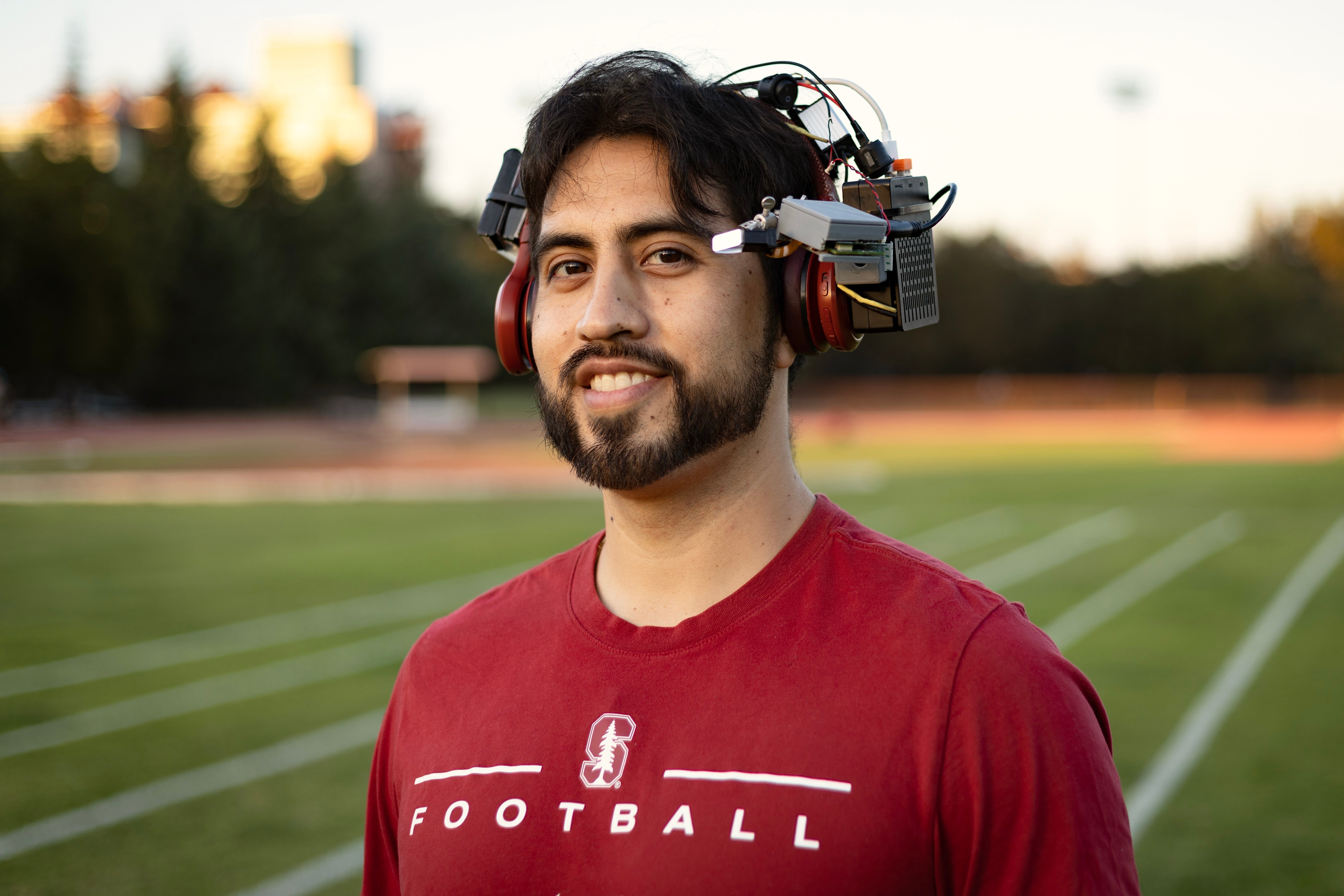Nearly a decade after packing his bags and moving to Mexico to try out for a professional soccer team, Kevin Ubilla M.S. ’26 is building a gadget that he thinks might revolutionize the sports field — and beyond.
Called Elis XR, Ubilla’s device combines a headset with a heads-up, augmented reality (AR) display. With the wave of a hand, a monocle-sized screen pops out, extends and slides neatly in front of a user’s field of view.
In its current iteration, Elis XR’s display screen can mirror anything displayed on a user’s phone. But the final version of the headset, according to Ubilla, will support an open-source, decentralized platform. This means developers will be able to build and sell apps specially designed for the headset.
Since deferring his Stanford enrollment to develop Elis XR, Ubilla has begun talks with several Bay Area sports teams to adopt the device as part of various pilot programs.
The device’s range of apps will allow athletes to fulfill various needs on the go, from Zoom meetings with coaches to reviewing daily workouts, Ubilla said. The headset will also come preinstalled with a fitness tracking app that allows athletes to access information about their health.
At first glance, the headset is reminiscent of previously failed “smart glasses,” including Google Glass, the once-hyped product that famously fell out of favor after various bugs and privacy concerns. Ubilla says that because Ellis XR is being catered toward athlete needs, the headset fills a specific niche in the AR market that Google Glass never filled.
“Google Glass failed because it tried to appeal to everybody,” Ubilla said. “It never solved a single use case. It never addressed a single real problem that people had.”
But the other problem associated with Google Glass that Elis XR hopes to address, according to Ubilla, is its inconvenience. According to Elizabeth Childs, a second-year mechanical engineering Ph.D. student, current AR headsets are not only exorbitantly priced, but also just too large — a major obstacle given the advantages of a headset-style design over other AR mediums.
“If it weren’t for the cost and form factor, I’d definitely use one,” Childs said. “It’s a much more realistic experience than looking through a screen. You can just have things right in your vision as needed.”
Ubilla says Elis XR’s emphasis on convenience separates it from other headsets, with its hand-wave-controlled, retractable display screen that remains both unobtrusive and flexible for daily use.
“Part of the reason why Google Glass didn’t work was because people didn’t want this thing 24/7 on their faces,” Ubilla said. “With this headset, the screen can whip out, then get out of the way after you do what you need to do.”
The idea for Elis XR is partially rooted in an unsuccessful athletic career. After Ubilla failed to make the first team for Mexican soccer squad Fuerzas Basicas as a teenager, he pivoted toward academia. At UC Berkeley, Ubilla attempted to switch from soccer to football, but struggled to memorize his team’s playbook and again found himself unable to receive playing time, which motivated him as he began brainstorming Elis XR.
But athletics is just the first step for Ubilla, who has a grander vision for his project. Ubilla envisions Elis XR as something that can be adopted by more than professional athletes, which he sees as an initial foothold to enter a market of largely unsuccessful products.
One industry on the radar for Ubilla is gaming: a space where even the slightest of advantages can mean the difference between victory and defeat. Ubilla said one source of frustration for competitive gamers is the fact that many first-person shooter games require toggling between menus, which often means taking eyes off of the main play screen. Elis XR addresses that shortcoming with its display screen, which Ubilla hopes can separately host these menus to the side.
But there are a variety of other contexts in which AR headsets like Elis XR might find use, according to Childs, who studies the applications of AR in education. Childs envisions using AR headsets as a way to realistically simulate chemistry labs in schools with limited funding or resources.
“The idea is that you’re combining digital and real experiences,” Childs said. “For instance, with a chemistry lab, you can use liquids like water or oil to simulate the physical composition and then have an overlay of the visual changes.”
Jeremy Bailenson, a communications professor and founding director of the Virtual Human Interaction Lab, wrote in an email to The Daily that AR also has value in telepresence: the preservation of the “spatial layout of a conversation.”
Bailenson, who teaches COMM 166: Virtual People, a class taught primarily in virtual reality, pointed toward AR’s ability to preserve “spatial cues like eye gaze and interpersonal distance” in a way that mimics real-world interaction.
Ubilla’s ultimate goal is for Elis XR to completely replace the smartphone altogether. By hosting its own decentralized apps, the headset looks to offer its own AR alternative to mobile computing, Ubilla said, something that he calls the “next step forward” in the field.
“I want to take people from a heads-down display to a heads-up display,” Ubilla said. “Instead of looking down at our phones, we can look up at an immersive experience — one that’s integrated into our everyday lives.”
